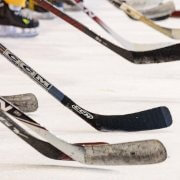Field Hockey Stick – Short and Unique

Why are field hockey sticks so short?
If you’re relatively new to the game of field hockey, you may wonder why the players’ sticks are so short. Most of the time, the players are in a forward bent position to keep the stick near the ball and the field’s surface, but wouldn’t it be better if they played with long sticks?
A field hockey ball travels very fast, and you need a maneuverable stick to control, launch, or stop such a fast-moving ball. Research has shown that a longer stick might give more leverage, but the short stick, combined with the forward-bending body position, is more functional on a field that provides shoe-grip.
In this article, we’ll answer the question “Why are field hockey sticks so short?” by looking at aspects influencing the stick’s shape and length and how uniquely it is constructed to be efficiently used in a game.
Field Hockey Stick vs. Ice-Hockey Stick
Although the modern game of field hockey as we know it today was developed in England in the mid-1800s, it all started centuries ago. Sports historians can trace it back to similar types of games played in early civilizations.
It seems as if the games that have evolved in today’s field hockey have always been played with a relatively short piece of wood, maneuvering a movable object over a rough surface.
Today, field hockey is played widely across the world — still with a short stick. It is the second-largest team sport globally, and it has become a popular family-oriented sport, played in clubs by both men and women (source).
The short stick is still used today because of its efficiency on a field where the player’s boots grip onto the surface. Players tend to bend forward when running and striking the ball on such a surface compared to ice.
The short stick compliments this position and enables you to put your body’s weight into the strike. Thus, the bent body and short stick were always accepted as the best way to play.
Ice-hockey players use a long stick for many reasons, but the main reason is related to the surface on which they play. A short stick would force the player to hunch over more, causing the player to lose power, reach, and balance on the ice.
Acceptance of the Short Length over Time
In the mid-1800s, when field hockey players and administrators started to formalize rules for the game, only three parts of a hockey stick were named in the rule book. These were the head, the handle, and the splice, without any reference to length.
Early Specifications
In the first rule books, only six stick specifications were included. It prescribed that the stick had to be flat on the playing side, able to pass entirely through a two-inch ring, be without rough or sharp edges, have a curved head made from wood, and weigh between 12 and 28 ounces.
The early rule books did not mention the length of the stick. However, it was accepted as an unwritten rule that the field hockey stick would be approximately 35 to 40 inches long. Since 2016, the rule books have stipulated that the stick’s maximum length should be no more than 41 inches.
Personal Preferences
The player’s personal preferences and height determine the stick’s optimal length, and the player has to feel comfortable and in control when handling the stick. There are two widely used measuring methods to give a starting point for determining the right length for your stick.
While holding the stick at your side, the top should be two inches below your waste. With the Dutch method, hold the head of the stick in your armpit, and the correct length stick should end in the middle of your kneecap.
This personalization of the stick’s length is the main reason why players generally don’t swap sticks with other players. Even juniors prefer their own sticks.
Utilizing the Shorter Stick
In field hockey, the ball can travel up to 70 miles per hour, and your stick must be able to stop it. It must also enable you to send the ball quickly.
Field hockey enthusiasts agree that stopping fast-moving balls and performing powerful strikes can be best performed on a hockey field with a short stick with the player in a slightly forward bent position.

Image by Wilf Ratzburg via FreeImages
Different Type of Strikes
When in offensive mode, the push and lift-to-flick strikes need absolute control. This is achieved by holding the stick with both hands near the top, transforming the stick into an extension of the body to get as near to the ball as possible. With a long stick, the player would lose this level of feel and control (source).
The same principle applies to the hit or sweep-strikes needed to send the ball over long distances and into the goal box. By using the stick more as a body extension than an external tool, you can provide much more power into the strike.
When the player is in defensive mode, the body-extension principle is even more noticeable. With jab or reverse tackle, only one hand is in contact with the stick. By gripping the stick at its top, the player uses it as an extended arm. A long stick would perhaps give you a longer reach, but it wouldn’t provide enough stability.
Variation by Playing Position
Your playing position could also dictate a slight difference in the length of your stick. Generally, forwards and midfielders prefer a slightly shorter handle, whereas fullbacks and sweepers prefer longer handles.
Unique Characteristics of the Short Hockey Stick
The sports industry conducts ongoing research to better the stick’s material and construction without changing its characteristics.
Material
Field hockey sticks were traditionally made of wood. Nowadays, modern technology and scientific research are utilized to construct well-balanced sticks capable of delivering powerful strikes. The construction of every section of the stick requires specialized attention to provide more durable sticks.
Besides wood, other materials like fiberglass, aramid, kevlar, or carbon fiber composites are currently used. Due to the risk of injury from sharp edges, they cannot use metal should the stick break in play.
The stick has a round grip covered in a non-slip, sweat-absorbent fabric tape made from materials like chamois leather.
In developing new material combinations, manufacturers must keep within the current maximum permitted weight of 25.9 ounces.
Sticks made from carbon are slightly heavier and more expensive, and, generally, only advanced and elite players use carbon sticks. The fiberglass-based sticks are lighter and cheaper and ideal for beginners and youth players (source).
Stick Sections
The modern stick consists of a rounded handle, with a grip at the top, and the splice, where the handle fits into the head’s shaft. The head has a J-shaped hook flattened on one side, called the face-side. There are no specialized sticks for left-handed players.
Traditionally, there is a slight curve, called the bow, from top to bottom at the stick’s face side.
Another curve is located on the other side of the handle, according to the angle at which the handle is inserted into the splice. The curves assist with the stick head’s positioning in relation to the ball and makes striking the ball more manageable and more accurate (source).
Every section is designed for better performance with researchers continuously changing design-details, and they often have to adapt to new manufacturing requirements. In contrast, the game rules may have to adjust to accommodate new developments.
Recently, developers discovered it is easier to get high speeds from the drag flick when the face bow’s depth is increased. The hockey rules now limit this curve to under 1 inch (25mm) to restrict the player’s power when flicking the ball.
The hook at the bottom of the stick developed into the modern tight curve. The older sticks had a longer bend, making it difficult to use the stick on the reverse.
Ongoing Development
There have been more stick design changes in the last 25 years than there were in the previous 125 years, and the tempo is increasing. There will be further developments, especially regarding the materials used, and many rules may have to change to accommodate this.
To verify the increasing tempo change, we’ve looked at the stick design changes over the years. From the 1860s up to 2004, about 10 to 12 radical stick design changes were developed and introduced. Since 2004, more than 12 new changes have been implemented. These include:
Redefining the length of the head.
- Refining head shapes.
- Introducing composites material instead of wood.
- Increasing the bow of the face of the handle.
- Introducing low bow sticks.
- Formalizing minimum and maximum weight and length.

Image by Patrick Case via Pexels
Final Thoughts
For the field hockey spectator, the players’ short stick and bent posture can look uncomfortable, but the short stick has proven to be the best for the level of maneuvering and control needed in this fast-paced game. Stick manufacturers are continuously researching and producing more effective sticks.




